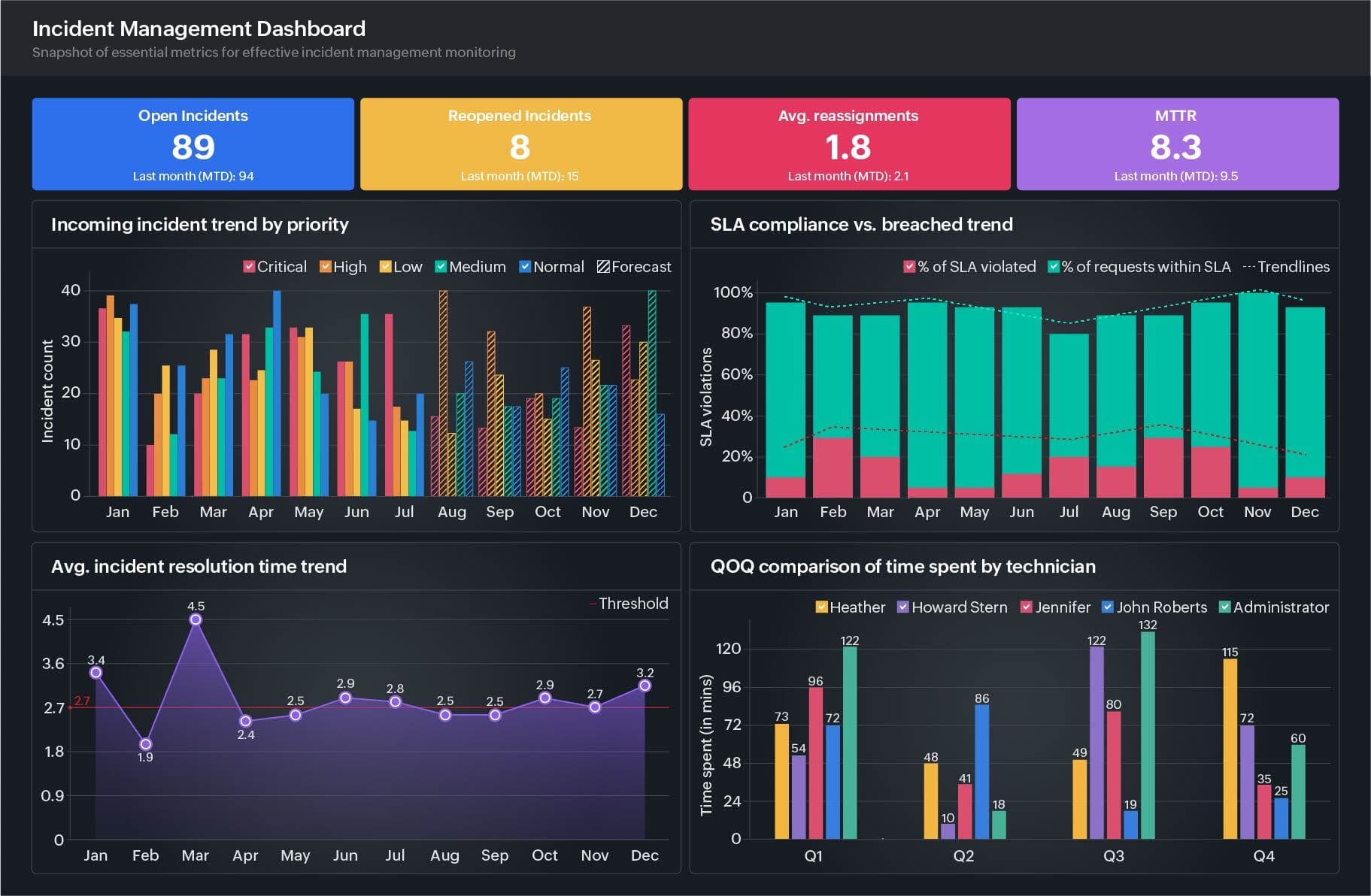An IT incident manager's role and responsibilities within a digital enterprise
July 11 | 07 mins read

Who is an IT incident manager?
IT incident managers, who are sometimes known as incident commanders, hold the overarching responsibility of managing an organization's incident response, from delegating various incident response tasks to communicating and coordinating with every stakeholder.
An IT incident manager in action
Consider a global e-commerce platform that experiences a sudden surge in traffic during a sales campaign. As millions of users flock to the website, unforeseen technical glitches begin to emerge, resulting in an influx of incident reports on website slowness.
Against this backdrop, the mantle falls to the IT incident manager to assign, manage, communicate, and escalate the incident response. The IT incident manager analyzes traffic patterns, server loads, error logs, and user reports to understand the root cause of the issue. With a clear understanding of the challenges at hand, the incident manager mobilizes experts from various domains, including network infrastructure, server management, database administration, and the IT service desk, to tackle the website issues head-on.
They quickly identify the root cause of the performance degradation—a bottleneck in the website's database infrastructure. To alleviate strain on the system and minimize disruption to the ongoing sales event, the IT incident manager works with the infrastructure teams to implement temporary measures such as load balancing or caching mechanisms to optimize performance in the short term. While addressing the immediate concerns, the IT incident manager simultaneously conducts a comprehensive analysis to identify long-term solutions that will prevent similar incidents from occurring in the future.
Throughout the incident response process, the IT incident manager maintains transparent communication with stakeholders, including senior management and other relevant parties, providing regular updates on the progress of resolution efforts and managing expectations regarding the impact on the sales event.
By taking decisive action, coordinating response efforts, and implementing effective measures, the IT incident manager plays a critical role in navigating the e-commerce platform through this challenging scenario, ensuring minimal disruption to business operations and preserving the integrity of the sales event.
The role and responsibilities of an IT incident manager
The responsibilities of IT incident managers encompass a wide range of tasks, including:
- Leadership and oversight: An IT incident manager provides strategic leadership and meticulous oversight of the incident management process. They help IT service desks navigate through the incident life cycle, collaborate with various teams, and devise incident response strategies to minimize the impacts of disruptions.
- Resource management: Incident managers allocate resources, including personnel, tools, and infrastructure, to promptly address incidents and ensure effective resource utilization. Additionally, they monitor the workload of the incident response team for smooth operations during the incident management process.
- Coordination and communication: Incident managers coordinate with various teams involved in incident response and delegate tasks to specific team members, including technical support teams, IT operations teams, and external vendors. They facilitate communication between stakeholders, provide regular updates on the status of incidents, and manage expectations regarding resolution timelines.
- Decision-making and problem-solving: During incident response, IT incident managers facilitate decision-making processes, guiding teams in identifying and implementing effective solutions to resolve incidents promptly.
- Root cause analysis: Incident managers lead the investigation of incidents to determine their root causes and underlying issues. They oversee the implementation of corrective and preventive measures to address root causes and prevent recurrence of incidents in the future.
- Continuous improvement: Incident managers drive efforts for ongoing improvement by conducting post-incident reviews and applying insights gained to enhance the effectiveness and efficiency of the incident management process. They analyze incident trends, identify areas for improvement, and implement changes to prevent similar incidents from occurring in the future.
- Documenting incident details and actions: Incident managers ensure comprehensive documentation of incident details, response actions, and outcomes, recognizing their importance for analysis, compliance, and future improvement efforts.
Essential skills required for an IT incident manager
To be effective, an IT incident manager must possess a blend of technical, managerial, and interpersonal skills.
- Technical expertise in security, networking, and systems is essential, along with proficiency in project management and organizational skills for executing incident response plans.
- Leadership and teamwork capabilities are crucial for motivating and coordinating team members effectively.
- Effective communication and presentation skills are necessary for delivering clear and tailored messages to diverse audiences.
- Analytical skills, critical thinking abilities, and stress management techniques are vital for evaluating situations, creating informed strategies, and navigating the pressures of incident management.
- Obtaining relevant certifications such as ITIL® Foundation, Certified Incident Manager (CIM), Certified Information Security Manager (CISM), or other certifications specific to incident management can enhance the qualifications and credibility of an IT incident manager.
Challenges in the role of an IT incident manager
There are several challenges that accompany the role of IT incident manager.
Stress management
When managing incidents under tight timelines, it's crucial to effectively handle both time pressure and stress. This role inherently involves high-pressure situations, interacting with demanding stakeholders, and facing financial or reputational consequences. Effective stress management is essential to sustain performance and resilience in this demanding role.
Complexity
IT systems and environments are becoming increasingly complex with the adoption of new technologies, cloud services, and interconnected systems. Managing incidents in such complex environments requires the incident manager to understand intricate technical details of the systems and their dependencies.
Communication
During high-severity incidents, effective crisis communication is crucial for maintaining calmness, instilling confidence, and guiding stakeholders through the incident response process. Incident managers must be prepared to communicate clearly, address concerns, and provide assurance as needed.
Interpersonal dynamics and decision-making
Coordinating diverse teams and stakeholders with different priorities and perspectives requires strong interpersonal skills and conflict resolution abilities. IT incident managers must make critical decisions under pressure, which may lead to high-stakes outcomes.
Continuous learning
Continuous learning is essential for success, but it also makes an incident manager's role more complex. Rapidly evolving technology, diverse skill requirements, regulatory compliance, and the intricate nature of incidents necessitates incident managers to stay abreast of the latest trends, tools, and best practices in incident response and cybersecurity.
What essential tools does an IT incident manager require?
IT incident managers require a versatile toolkit designed to tackle the complex challenges inherent in IT incident management. Here's what they should prioritize in their ITSM software:
- Robust incident management practice: A comprehensive module for efficiently managing and tracking incidents from detection to resolution. This includes seamless integration with monitoring tools for real-time issue detection and automatic incident creation. Additionally, tighter alignment with other ITSM practices such as problem management, change management, and asset management can help synergize incident management by bringing clarity and context.
- Automation and workflow orchestration: Automation capabilities to streamline repetitive tasks, such as ticket assignment, task management, notification management, escalations, and more. Workflow orchestration facilitates a structured incident management process, ensuring seamless coordination among teams and systems, thus reducing manual effort and expediting resolution times.
- A configuration management database (CMDB): A CMDB to provide comprehensive visibility into critical IT components, encompassing hardware, software, and configurations, which is instrumental in aiding incident understanding. Relationship mapping within the CMDB helps identify dependencies, thereby facilitating incident diagnosis and resolution.
- Communication and collaboration features: Robust communication and collaboration channels that integrate seamlessly with popular platforms such as Microsoft Teams, Slack, and others. These capabilities help foster real-time interaction and collaboration among incident management teams, stakeholders, and end users.
- Knowledge base: A centralized repository for storing incident-related knowledge articles, standard operating procedures, troubleshooting guides, and historical incident data to aid in incident resolution, knowledge sharing, and continuous improvement.
- Reporting and analytics tools: Capabilities for generating insights into incident trends, performance metrics, SLA compliance, and areas for improvement, enabling data-driven decision-making and continuous service improvement.
What does an incident manager's dashboard typically look like?
An incident manager's dashboard highlights key metrics and indicators, such as the count of open incidents, their severity levels, and their current statuses. Charts or graphs are commonly utilized to depict trends over time, such as incident volume, SLA breaches, resolution times, number of reopened incidents, and more. These features empower informed decision-making and promote efficient incident management. Figure 1 illustrates a dashboard commonly used by IT incident managers.

What capabilities does ServiceDesk Plus provide to
IT incident managers?
ServiceDesk Plus empowers IT incident managers to streamline their incident management workflows. With its automation capabilities, SLA management, knowledge base, and integrations, ServiceDesk Plus enables IT incident managers to respond swiftly to incidents, minimizing downtime and ensuring uninterrupted business operations. Its powerful reporting and analytics tools allow IT incident managers to gain valuable insights into incident trends, identify areas for improvement, and make data-driven decisions.
Request a demo today and empower your IT incident managers to mitigate disruptions, minimize downtime, and maintain service quality standards.
About the author





